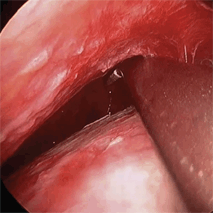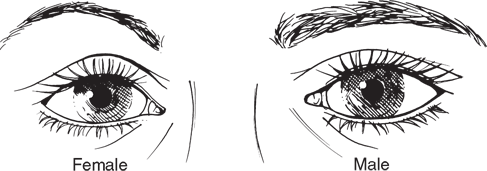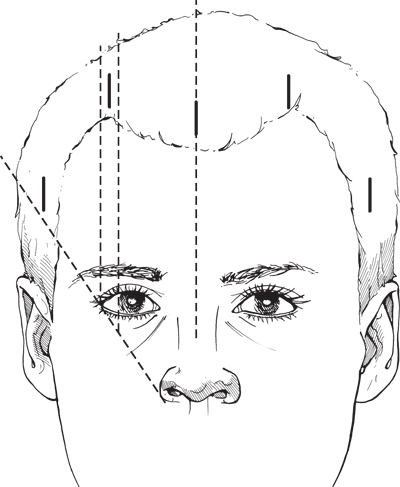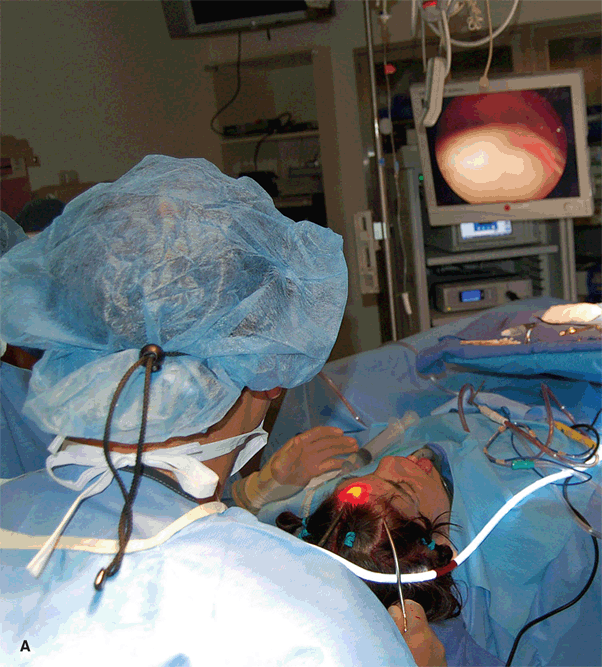Endoscopic Eyebrow and Forehead Lift

INTRODUCTION
The endoscopic eyebrow and forehead lift is one of several procedures utilized to correct ptosis of the upper face, as well as to reduce rhytids in the forehead and glabellar regions. In contrast to the open coronal lift, the endoscopic procedure accomplishes its aesthetic goals with smaller, localized incisions. Although the indications and outcomes are similar, the endoscopic eyebrow lift offers several advantages over the open coronal lift. The smaller incisions in the endoscopic approach decrease the risks of intraoperative hemorrhage, postoperative scarring and alopecia, postoperative hypesthesia, and speed recuperation. This approach can also be offered in patients with thinning hair because the scars can be hidden in selective areas and are less conspicuous than a coronal incision. The endoscopic approach, however, requires a higher level of training, particularly with respect to knowledge of the anatomy and the use of specialized equipment. Nonetheless, it is a powerful technique for the treatment of eyebrow and forehead ptosis and should be in the armamentarium of every oculofacial surgeon.
PREOPERATIVE EVALUATION
Eyebrow ptosis is present when the eyebrow rests below the level of the superior orbital rim.

Figure 15-1. In women, the eyebrows have a higher arch with its apex in line with the lateral corneal limbus. In men, the eyebrows have a flatter arch and is positioned closer to the orbital rim. Before surgery, all patients should have a full ophthalmic exam with special attention to the integrity of the tear film and cornea, as well as any preexisting eyelid malpositions, such as eyelid retraction and lagophthalmos. Patients with a history of dry eyes should be advised of the possibility of their worsening symptoms. The eyebrows should be manually elevated to the desired position to assess the need for concurrent upper eyelid blepharoplasty. The length of the forehead should be noted, and if the patient is adverse to any increase in its length, other options, such as a pretrichial lift, should be discussed. The scalp is examined for alopecia, and men with early male pattern baldness should be warned that scars may be visible later when their hair pattern changes. Panoramic facial photographs should be taken.
Patients should be advised to stop aspirin and other blood-thinning agents for week prior to their surgery, unless contraindicated by their primary care physician or cardiologist. If anticoagulation cannot be suspended, it is our practice to defer elective surgery. Lastly, on the day of surgery, patients are asked to wear clothing that does not require removal over their heads since a head dressing is applied at the conclusion of the case.
SURGICAL TECHNIQUE
Markings and patient positioning
With the patient in the upright position, the amount of brow ptosis is assessed and the superior eyebrow margin marked. The eyebrows are then manually elevated to the desired position, and if concurrent blepharoplasty is to be performed, the amount of skin to be excised is determined. The desired contour of the brow is also evaluated.

Figure 15-2. Next, in the supine position, five incision sites are marked. One vertical central mark is made approximately 1 cm posterior to the hairline. Then two paramedian vertical marks are made, also 1 cm posterior to the hairline, in line with each lateral limbus or corresponding to the apex of the desired peak of the tail of the brow. Finally, two temporal horizontal marks are made 4 cm posterior to the hairline, in line with the preauricular crease, and transected by an imaginary line from the nasal ala through the lateral canthus. The central and paramedian incisions are generally 2 cm in length and the temporal incisions are 3 to 4 cm in length. They are, however, made smaller in non–hair-bearing areas and anterior to any regions of thinning hair to prevent damaging the hair follicles. The hair is then parted along the incision marks and secured with rubber ties. The entire face, scalp, and back of head are prepped with 5% povidone-iodine paint. The head is then placed on sterile towels allowing free movement. The split sheet is brought to the base of the chin, with the free ends covering the neck and shoulders.
Surgical equipment and instruments

Figure 15-3A. The endoscope monitor is placed at the foot of the bed. This allows the surgeon to view the monitor easily while working.
Stay updated, free articles. Join our Telegram channel

Full access? Get Clinical Tree


